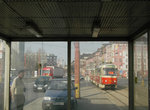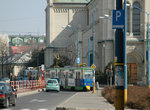Bratislava, Slovak Republic
![]()
Bratislava Tatra K2 tram at Hlavná Stanica. Photo by Peter Ehrlich, March 2006.
Overview
The former Eastern Bloc city of Bratislava, now capital of the Slovak Republic, is home to an interesting tram system consisting of thirteen routes, two of which are rush hour-only. With the exception of several restored historic cars still owned, the tram fleet consists entirely of cars built by Czech company Tatra; the oldest date from the early 1970s with the newest constructed during the late 1990s. Of the older cars, several have been rebuilt in house by Dopravný Podnik Bratislava, the local public transit undertaking.
Roster
There are four different types of car in the operational fleet:
Tatra T3SU/T3SUCS - The most numerous type in the fleet, they have one cab each and are arranged into two-car units, one a permanent trailer. Both cabs point forward, and that in the second car has no mirrors, windshield wipers and such. The door from the passenger compartment to the trailing unit's cab is often padlocked shut. Whilst they operate as twin-car sets it would seem that occasionally (presumably due to equipment shortages) single car units are operated in service, although it's possible that some cars could be permanantly operated as single units. Some cars are fitted with dot-matrix destination screens whilst most retain the traditional boards. Whilst a handful have received full modernisation, and some a 'mini-upgrade', the majority seem to run in as-delivered condition.
Tatra K2 - Articulated cars which, whilst similar in appearance at the front and rear to the T3SUCS cars above, are smaller and feature a partialy-corrugated side, very similar to that on New York's R32/38 subway cars. The most obvious difference is that the K2 cars are three-truck articulated cars with a turntable between the two sections of the car. As their capacity is lower than that of the other types of cars in the fleet, they seem to be restricted to quieter routes 3 and 13. Many of these cars have been rebuilt - see below.
Tatra K2 rebuilt - Many of the elderly articulated K2 type cars have been totally rebuilt and, to the uninformed observer, would seem to be brand new trams. They now have the appearance of a modern LRV, complete with dot-matrix destination indicators and a new window arrangement, and have lost the corrugated sides. The cab has a new control console and a roof-mounted air conditioning unit, whilst the interior has been thoroughly modernised. These cars can be found on routes 13 and 14. At least one unit (#7085) has received a 'mini-upgrade', consisting of all the above except the new front and rear, retaining its as-new appearance in these places. No cab air-conditioning unit would appear to be fitted to this car.
Tatra T6A5 - The most modern type of car in the fleet, 56 of these cars entered service between 1991 and 1997. As with the Tatra T3SU/T3SUCS, they are coupled into two-car sets; the lead car is even-numbered and the trailing car the consecutive, odd, number. All are fitted with dot-matrix destination equipment and most carry all-over advertising liveries. They can mainly be found on routes 5, 9, 11 and have a very angular look.
An unusual feature of Bratislava trams is the high percentage of cars carrying overall advertising liveries, particularly the Tatra T6A5 and to a lesser extent the K2 rebuilt types. On the remaining cars, several versions of fleet livery are to be seen. One is a traditional red and cream scheme, very similar to that of Prague's trams, whilst a more modern version consists of a pleasing combination of red, blue and gray. The latter can be found on those K2 rebuilds that don't carry all-over adverts and a handful of T6A5 cars. A few T3SU/T3SUCS cars carry a hybrid red and gray design.
Of the thirteen routes operated, line 7 operates during the afternoon rush only, and line 17 only during the morning peak period. Of the remaining eleven, there is much duplication of routes, with terminals being shared by at least two lines. These terminals are:
Pri Krízi (Dubravka), which is served by routes 1,5 and 12 and is situated in the north-west of the city amongst high-rise apartment blocks. It consists of a large, three-tracked loop which surrounds a grassed area. Several bus routes terminate here;
Karlova Ves, situated alongside the running lines a few kilometres south of Pri Krízi, and used by routes 4, 9 and the part-time 17. Upon leaving the terminal, these routes cross into the median of a road to join the right-of-way used by routes 1, 5 and 12;
Hlavná Stanica, the city's main railway station which is a couple of kilometres to the north of the city centre. This is served by routes 2, 3, 8 and 13 and has a three-tracked loop, one track of which is used exclusivley by route 13. This is a result of route 13's greater layover time at Hlavná Stanica, with the result that trams on other routes need to 'overtake' those on route 13. There is a large covered waiting area, and the main-line railway station is accessed by an escalator, as are the multitude of buses that terminate here.
Nám. L. túra forms part of a downtown loop used as a terminal by routes 11, 12, 13 and 14. The loop is also used by route 1, although is doesn't terminate here. A portion of this loop passes several architecturally stunning buildings, whilst the tracks are set in a pleasing sand-coloured stone. The Nám. L. túra platform is a large triangular island, and is very close to the banks of the Danube.
Astronomická (Ruzinov) is the terminal of routes 8,9 and 14, which arrive here via a long, straight run along a road median. This is a bleak area consisting of housing and industrial units, whilst the terminal is the usual three-tracked loop enclosing a grassed area.
After diverging froom routes 8, 9 and 14 at Trnavské mýto, trams 1, 2, 4 and 7 proceed via a highway median to Zátiie, where routes 1 and the PM rush-only 7 diverge to the east, continuing a short distance until they terminate at ST Nové Mesto in a small loop adjacent to the main-line railway station. Routes 2 and 4 continue along the median to Zlaté Piesky, which consists of a small two-tracked loop in an industrial area. Several local and long-distance buses drop passengers adjacent to the tram stops.
Finally, routes 3, 5, 7, 11 and 17 proceed north from the city centre, with part-time routes 7 and 17 terminating in a small loop at ST Vinohrady, a small railway station served by the state railway company. Routes 3, 5 and 11 continue north through a pleasant neighbourhood, and include some on-street running before terminating at Komisárky (Raca). This two-tracked terminal is in the shadow of a cluster of high-rise Communist-era apartment blocks, which are of a somewhat threatening appearance.
Photo Gallery
| Five Random Images | ||||
 Image 44328 (181k, 824x618) Photo by: Tim Deakin Location: Karlova Ves |  Image 44331 (132k, 824x618) Photo by: Tim Deakin Location: Zlaté piesky |  Image 55793 (184k, 864x563) Photo by: Peter Ehrlich Location: Americké náměstíe |  Image 55823 (184k, 864x574) Photo by: Peter Ehrlich Location: Trnavské mýto |  Image 55836 (218k, 864x574) Photo by: Peter Ehrlich Location: Floriánske náměstíe |
Page Credits
By Tim Deakin